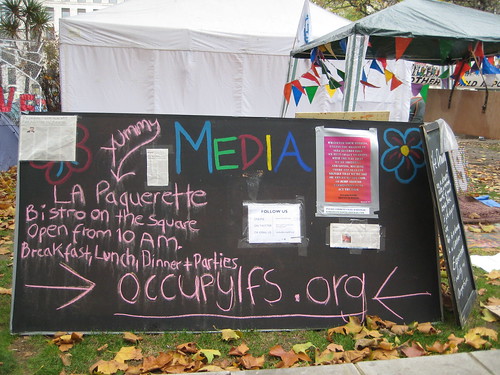
Since the very beginning of the movement, Occupy has had a tense, and very often adversarial, relationship with the mainstream media. This should not come as any surprise—corporate media outlets are considered by Occupiers to be the mouthpiece of the One Percent’s policy preferences, and could therefore be expected to attempt to stifle the movement’s message, whether through a lack of coverage or through aggressively biased stories.
However, this did not change the standing fact that an act of civil disobedience needs some kind of publicity in order to be effective; otherwise, the act is simply a criminal one.
Occupiers criticized large national media outlets for not being on hand for the early days of the protests in New York City last fall. (In full disclosure, I was asked to come interview the protesters during their first weeks while I was covering the UN General Assembly; not realizing the movement’s potential at the time, I declined in order to cover other side events such as the Clinton Global Initiative and protests against Iranian President Mahmoud Ahmadinejad.) It was not until tents began to appear in public places that ears began to perk up. Finally, Occupy “went viral” with a YouTube video showing several college-aged girls corralled then pepper-sprayed by NYPD officers, and the movement received the mainstream media coverage it craved.
In this moment, however, Occupy’s media efforts would begin to take a new direction.
In the frenetic American 24-hour news cycle, even a viral hit will not hold an outlet’s attention for long, and in order to justify a few precious minutes of the nightly news’ attention, there must be something radical happening. So coverage of Occupy moved away from an analysis of the issues and philosophy driving the people on the streets, but toward superficial and sensationalized—but marketable—stories of violence, anarchy, and drama. Headlines screaming about rapes and deaths were followed by stories peppered with extreme labels for protestors like “violent,” “lazy,” and “unwashed.” Meanwhile, stories of Occupy Wall Street’s public library and discussion groups garnered little attention until police forces dismantled them during the clearing of Zuccotti Park. Without a figurehead, and now without a central location as encampments were dispersed, to report on what is happening in the Occupy movement day-to-day on a national scale is a very difficult and time-consuming task.
However, Occupy has not exactly made a reporter’s job easy. When Martin Luther King, Jr. was attempting to get his message out, he knew that events with lofty calls for action and sweeping, dramatic movement would get press coverage because they lent themselves to headlines, quotes, and photos. Then once the headlines about events came, it was more feasible for news outlets to consider analytical pieces. Occupy, on the other hand, has seemed to shun the idea of staging actions that would cater to this media-through-public relations mindset, annoyed that superficial and expensive “publicity stunts” seem to be required to get attention in a system controlled by Big Money.
Instead, Occupy seems to be turning inward. The movement has always had an element of this, and has been, since the first day, reluctant to hold specific events catering to the press or to otherwise convincing those who may not be sold on their philosophies and tactics. Organizers who suggest such public performances have been, and still are largely shunned out of planning processes. On a recent conference call to organize for a Feminist General Assembly at the upcoming National Gathering (to be held in Philadelphia over the July 4th Independence weekend), one participant suggested a press conference of sorts by Occupy’s women and men alike to announce a proposed Gender Balance Amendment, which would call for equal representation of women and men in government institutions and would be sent to Congress and the White House. As a member of the press, I immediately began scribbling down her ideas, only to hear her be cut off and removed from the conversation. This amendment presentation idea was summarily ignored, and the conversation instead turned to organizing an Occupy the Night event consisting solely of a “ritualistic Wiccan dance party in the street” to express a woman’s innate “wildness and beauty” and to “feed [their] souls and spirits.” According to a poll taken by the call organizer, this idea was supported by 72 percent of the meeting participants.
Due to its reliance on social media venues to spread messages and communicate with other protesters in real time, Occupy has essentially begun having a conversation with only itself. Social media is a self-selecting venue. If a Facebook user does not want to create a Twitter account, that media consumer will not have access to all the conversations and news being created there; even many Twitter users will not ever see these conversations, as a consumer may not be at all interested in following such accounts, if they are even among the few to know the best accounts to follow. Therefore, it has been people who are highly interested (“hardcore,” if you will) in Occupy that have been best served by the tweets and Livestream videos, while the general population has been shut out of the conversation. It is beginning to reach the point where Occupy’s conversations no longer have any meaning for a layperson, as conflicting opinions and criticism are shut out and echoing opinions are allowed to impact the direction the rest of the community.
Chrisella Sagers is Managing Editor at the Diplomatic Courier.
For further information on the topic, please view the following publications from our partners:
Lessons from 2011: The New Media Revolution is a Strategic Asset
Does Media Policy Promote Media Freedom and Independence?
For more information on issues and events that shape our world please visit the ISN’s Security Watch and Editorial Plan.

